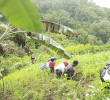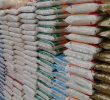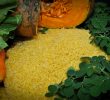DAVAO CITY – Survivors of Typhoon Pablo doubted that the government’s plan to shift to planting palm oil from coconut trees in Davao Oriental will help them recover from the 2012 disaster, saying it will only “intensify land-grabbing” of their farm and ancestral lands.
“Instead of giving support services to farmers in replanting and keeping our lands productive, they push us to the mercy of agribusinesses owned by multinational corporations that will turn us into contractual farm workers,” said Karlos Trangia, spokesperson of Barug Katawhan, an alliance of Typhoon Pablo survivors in Davao Region.
“This is an institutionalized land-grabbing,” he added.
Agumil is a leading oil palm exporter based in Caraga region.
Malanyaon said the target areas are in the towns of Boston, Baganga and Cateel, the hardest hit areas of the typhoon.
Malanyaon also said the palm oil plantation provides stable and faster sources of income after Typhoon Pablo left farmers wanting for livelihood.
The governor said she is “sold out” to oil palm production after seeing how this agro-industry product helped boost the economy of Malaysia.
Meanwhile, the Philippine Coconut Authority (PCA) said the target for oil palm plantations in Davao Oriental alone is 42,000 hectares.
Rex Buhat, regional manager of PCA in Davao Region, said they still consider the oil palm targets in Davao Region as “private venture” but they will assist in the planting process as part of their mandate.
Buhat said there are “advantages and disadvantages” in opting for oil palm over coconuts and cannot “prevent farmers from planting what they want.”
He said that farmers could earn more in oil palm “per hectare basis” as they can harvest every two weeks and can be productive for 25 years.
Buhat said that one advantage of planting coconut is that farmers can do intercropping or plant other crops or trees in between the coconut trees.
The farmers, though, have to spend more on fertilizers, Buhat noted.
He also added that farmers couldn’t dictate the price of copra in the market.
“If the price of copra goes down, farmers can harvest other crops because they can intercrop,” he said.
Buhat said that for their part, they have already assisted farmer-victims of Typhoon Pablo by paying for P40 per seedling for those who still want to plant coconut.
He added that they have already paid for a total of 416,570 seedlings in Davao Oriental covering 4,165.7 hectares.
If the oil palm plantation in Davao Oriental pushes through, there is still a large land area to be planted with coconut, he said.
But Buhat also admitted that most of their beneficiaries do not own land.
“Many of them don’t own land and are still only farm workers despite the agrarian reform program,” he said.
Davao Oriental is the country’s leading producer of coconuts with an average yield of one billion nuts annually covering area of 156,837 hectares, according to its provincial government website.
Typhoon Pablo destroyed the province’s agriculture at a cost of P450 million, according to a post-disaster report. (davaotoday.com)










